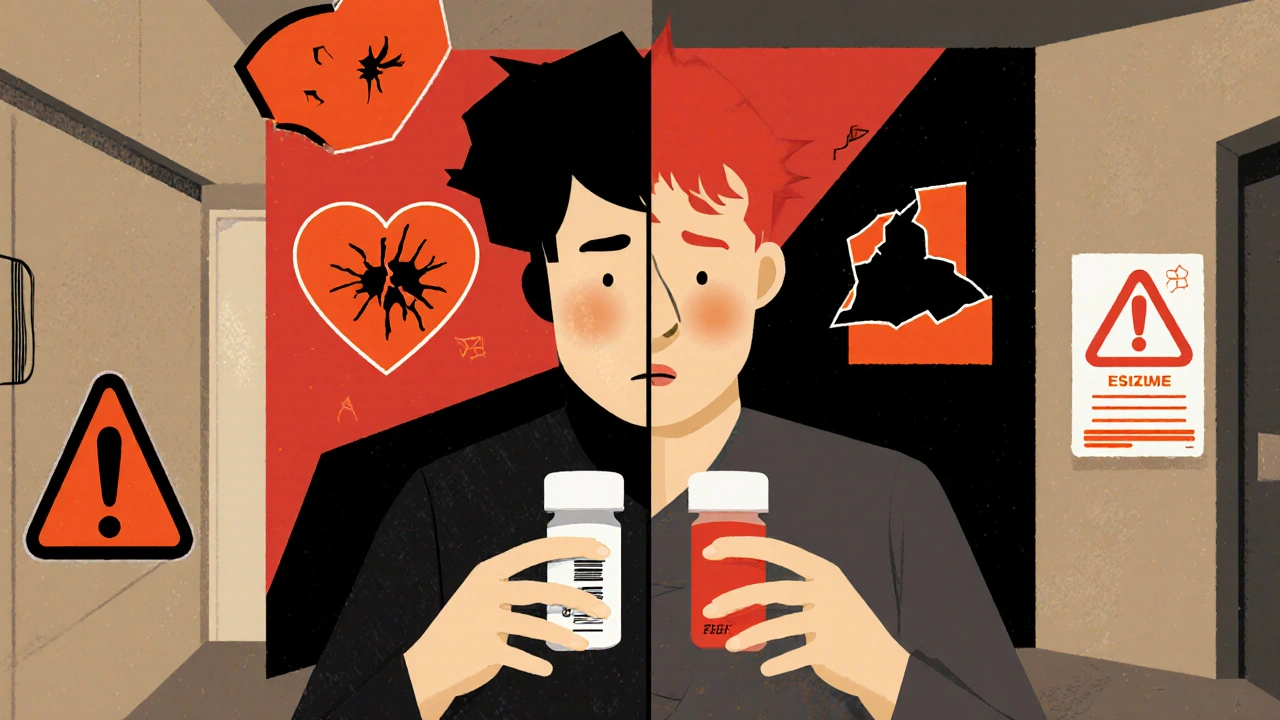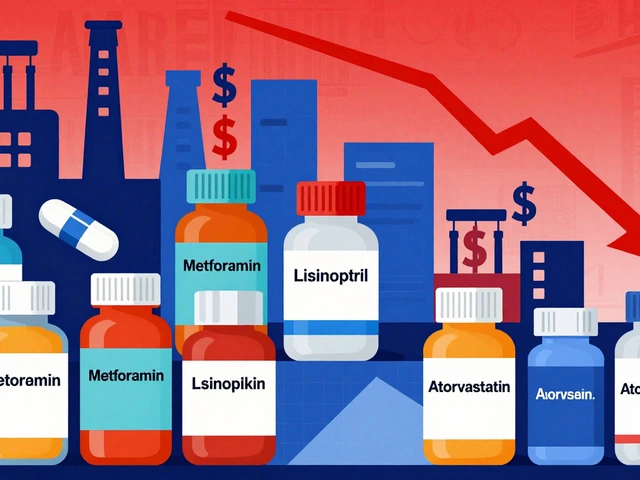Switching from a brand-name drug to a generic version is supposed to save money - and for most people, it does. But what happens when you start feeling worse after the switch? You’re not imagining it. Some people do experience real, sometimes serious, changes in how they feel after switching to generics. The good news? Most of the time, it’s nothing. The critical part? Knowing when it’s something you need to act on.
Why do side effects happen after switching to generics?
Generic drugs are required by the FDA to contain the same active ingredient, strength, and dosage form as the brand-name version. That means they’re designed to work the same way. But here’s what most people don’t realize: the inactive ingredients can be completely different. These are the fillers, dyes, preservatives, and binders that hold the pill together or help it dissolve. They don’t treat your condition - but they can trigger reactions in your body. For example, someone allergic to corn starch might react to a generic version that uses it as a filler, while the brand-name version uses potato starch. Or a dye like FD&C Red No. 40 might cause a rash in sensitive individuals. These aren’t flaws in the generic - they’re legal differences allowed under FDA rules. And while the active ingredient must be absorbed into your bloodstream within 80-125% of the brand-name drug’s rate, that 25% range can matter for certain drugs.Which drugs are most likely to cause problems?
Not all medications are created equal when it comes to switching. Some are very forgiving. Others? Not so much. Drugs with a narrow therapeutic index (NTID) are the ones to watch. These are medications where even a tiny change in how much enters your bloodstream can lead to treatment failure or serious side effects. Examples include:- Levothyroxine (for hypothyroidism): Even small shifts in thyroid hormone levels can cause fatigue, weight changes, heart palpitations, or mood swings. Studies show up to 15% of patients switching from brand to generic had abnormal TSH levels.
- Warfarin (a blood thinner): A slight increase in blood levels can cause dangerous bleeding. A drop can lead to clots. INR levels must stay between 2 and 3. If your INR suddenly moves outside that range after a switch, call your doctor.
- Lamotrigine (for epilepsy and bipolar disorder): Switching generics here has been linked to a 25% higher chance of seizures or mood episodes. One case study described a patient going into mania after a switch - requiring hospitalization.
- Phenytoin (another seizure drug): Blood levels need to stay between 10 and 20 mcg/mL. A small change can trigger seizures or dizziness.
- Sumatriptan (for migraines): Some patients report the generic just doesn’t stop their headaches like the brand did.
- Sertraline (an antidepressant): While most people see no difference, reports of increased anxiety, nausea, or sleep issues after switching are common.
If you’re taking any of these, pay extra attention after your pharmacist swaps your prescription.
Warning signs that mean you need to call your doctor
You don’t need to panic over every little change. But if you notice any of these, contact your doctor within 24 hours:- Skin rash, hives, or itching - Especially if it spreads or is accompanied by swelling. This could be an allergic reaction to a new filler or dye.
- Persistent nausea, vomiting, or diarrhea - Not just a day or two, but lasting longer than 48 hours. This can mean your body isn’t absorbing the drug properly.
- Unexplained fatigue or dizziness - If you suddenly feel like you’re dragging all day, or you’re lightheaded when standing, it could signal your drug levels are off.
- Changes in how well your medication works - Your migraines are back, your thyroid symptoms returned, your seizures increased, or your depression feels worse. If the drug that was working fine suddenly isn’t, that’s a red flag.
- Heart palpitations or chest pain - Especially if you’re on heart medication like warfarin, beta-blockers, or antiarrhythmics.
For people on NTID drugs, your doctor may want to check a blood level or lab result. For levothyroxine, that’s TSH. For warfarin, it’s INR. For phenytoin, it’s serum drug level. Don’t wait for symptoms to get worse - get tested.

Emergency signs: Go to the ER immediately
These are rare, but life-threatening:- Swelling of the throat, tongue, or lips - Could be anaphylaxis.
- Difficulty breathing or wheezing - Not just congestion. Actual shortness of breath.
- Systolic blood pressure below 90 mmHg - You might feel faint, cold, or confused.
- Severe confusion, loss of consciousness, or seizure - Especially if you’re on an antiepileptic drug and weren’t having seizures before.
If you experience any of these, call 911 or go to the nearest emergency room. Don’t wait. Don’t text your doctor. This is urgent.
What to do if you think the generic isn’t working
First, don’t stop taking the medication. Stopping suddenly can be dangerous, especially with antidepressants, seizure meds, or blood thinners. Instead:- Write down exactly what changed - when you switched, what symptoms started, how bad they are, and how long they’ve lasted.
- Call your doctor’s office. Say: “I switched to the generic version of [drug name] and I’m having [symptoms]. I’m concerned it’s not working the same.”
- Ask if you can go back to the brand-name version - even temporarily - to see if symptoms improve.
- If your doctor agrees, ask them to write “Dispense as written” or “Do not substitute” on the prescription. This legally prevents the pharmacy from switching you again without approval.
In 28 U.S. states, including California, pharmacists are required to notify your doctor before substituting generics for certain NTID drugs. If you live in one of those states, you have more protection. Ask your pharmacist if your medication is on that list.

Why some people are more at risk
It’s not just the drug. Your body matters too. Older adults, people with multiple chronic conditions, and those taking five or more medications are more likely to notice changes. Your liver and kidneys process drugs differently as you age. If you’ve had a recent illness, surgery, or started a new supplement, that can change how your body handles the generic. Also, if you’ve been on the same brand-name drug for years, your body may have adapted to its exact formulation. Even small differences in how the generic dissolves or is absorbed can throw off your balance.How to avoid problems next time
- Always ask your pharmacist: “Is this the same generic I’ve been taking?” If they say yes, but the pill looks different, ask why. Generics can come from different manufacturers - and even the same drug from two different makers can have different effects. - Keep a pill photo: Take a picture of your pill before you switch. If the new one looks different, you’ll know. - Check the FDA’s Orange Book: You can look up your drug online to see which generics are rated as therapeutically equivalent (AB rating). Avoid those with a B rating - they’re flagged for possible issues. - Don’t assume all generics are equal: One generic for sertraline might work fine for you, but another might not. If you switch manufacturers and feel worse, it’s not your fault - it’s the formulation. - Track your symptoms: Use a simple notes app or journal. Note your energy, mood, sleep, and symptoms daily for two weeks after a switch. That data helps your doctor decide what to do.Bottom line
For most people, generics are safe, effective, and save hundreds a year. But for a small group - especially those on critical medications - switching can cause real problems. The key isn’t to avoid generics. It’s to be informed, observant, and proactive. If something feels off after a switch, trust your gut. Call your doctor. Don’t wait. Your health isn’t a cost-saving experiment.Can generic drugs be less effective than brand-name drugs?
Legally, generics must deliver the same amount of active ingredient into your bloodstream as the brand-name version, within a narrow range. For most drugs, this means they work just as well. But for drugs with a narrow therapeutic index - like levothyroxine, warfarin, or lamotrigine - even small differences in absorption can affect how well they work. Some patients report reduced effectiveness after switching, and studies back this up for these specific medications.
Why do I feel worse after switching to a generic?
It’s usually not the active ingredient - that’s identical. The problem is often the inactive ingredients: fillers, dyes, or binders that your body reacts to. Some people develop rashes, nausea, or changes in how the drug is absorbed. For critical medications, even tiny changes in how fast the drug enters your bloodstream can cause symptoms like fatigue, mood swings, or seizures.
Which generic drugs have the most side effects?
Based on patient reports and studies, the top medications with the highest rates of side effects after switching are sertraline (antidepressant), lamotrigine (for seizures and bipolar disorder), and levothyroxine (for thyroid). These drugs have narrow therapeutic windows, meaning small changes in blood levels can cause noticeable effects. Reports of rash, nausea, mood changes, and reduced effectiveness are most common with these.
Should I avoid generics altogether?
No. For most people and most medications - like metformin, lisinopril, or atorvastatin - generics are just as safe and effective. The issue isn’t generics themselves. It’s switching without monitoring for drugs that need precise dosing. If your doctor says you’re fine to switch, go ahead. But if you’re on a critical medication, ask about the risks and whether your version is on the list of drugs where substitution needs extra care.
Can my pharmacist switch my generic without telling me?
In most states, yes - unless your doctor wrote “Dispense as written” or “Do not substitute” on the prescription. But in 28 states, including California, pharmacists must notify your doctor before switching generics for certain high-risk drugs like warfarin or levothyroxine. Always check the pill when you pick it up. If it looks different, ask why.
How long should I wait before calling my doctor after switching?
If you notice a rash, trouble breathing, swelling, or sudden worsening of your condition - call immediately. For milder symptoms like nausea, fatigue, or changes in how well your medication works, wait 24-48 hours. If symptoms persist or get worse, call your doctor. Don’t wait a week. Early action can prevent a bigger problem.








Kevin Wagner November 14, 2025
Bro. I switched my levothyroxine last month and felt like a zombie for two weeks. Tired all the time, brain fog, mood swings. Thought I was just aging. Then I remembered the pill looked different. Called my doc, they checked my TSH - it was off the charts. Switched back to brand, I’m human again. Don’t ignore this stuff. Your body knows.
Generics are fine for ibuprofen. Not for life-sustaining meds. Period.
gent wood November 15, 2025
This is an incredibly important post. I’ve seen too many patients in my practice assume ‘same active ingredient’ means ‘same experience.’ The inactive ingredients can trigger immune responses, GI distress, or even alter absorption kinetics - especially in elderly patients with reduced liver or renal function. I now routinely document the manufacturer and batch number for NTID drugs. If a patient reports a change, we revert immediately and request a ‘dispense as written’ prescription. Prevention beats crisis.
Dilip Patel November 17, 2025
USA too much drama. In India we use generics since 1990s and no problem. Your body weak, not the medicine. Why you always think you special? Generic is same, FDA stupid. We take 10 different generics daily and live long. You need better diet, not better pill. Stop whining.
Jane Johnson November 18, 2025
I find it concerning that the FDA permits such variability in inactive ingredients. It is not merely a matter of preference; it is a matter of physiological consistency. The 25% bioequivalence window is statistically acceptable but clinically reckless for vulnerable populations. This is not a cost-saving measure - it is a systemic risk allocation onto the patient.
Peter Aultman November 19, 2025
My mom switched her warfarin generic and her INR went from 2.4 to 3.9 in a week. She didn't feel different until she started bruising like a cartoon. We called the doc same day. They switched her back. Now she gets the brand and her med is covered. Worth every penny.
Don't wait till you're bleeding out to act. Your life isn't a budget spreadsheet.
Sean Hwang November 20, 2025
I’m a pharmacist. I see this all the time. A lot of folks don’t realize the same generic can come from different factories. One batch might have corn starch, next batch potato. One looks blue, next looks green. Even if it’s the same company, the binder changes. If someone says they feel weird after a switch, I check the pill image. If it’s different, I call the doc. Simple. No drama. Just do it.
Barry Sanders November 20, 2025
Wow. Another overblown fear-mongering post. People get sick because they’re lazy, not because generics are evil. You’re just conditioned to pay more for branding. If your body can’t handle a generic, maybe you’re not healthy enough to be on meds at all. Get real.
Chris Ashley November 22, 2025
My doc switched me to generic sertraline and I started crying in the shower every day for 3 weeks. Thought I was going crazy. Then I saw the pill was smaller and white instead of blue. Called my pharmacy - they said ‘it’s the same.’ Bullshit. I went back to brand. My therapist said I looked like a different person. Don’t let them do this to you.
kshitij pandey November 23, 2025
From India, I want to say thank you for this post. Many people here don’t know about NTID drugs. My cousin switched his lamotrigine and had a seizure. He was lucky. Now we educate everyone - if it’s for epilepsy, bipolar, or thyroid, always check the pill. Take photo. Ask pharmacist. Don’t trust ‘same thing.’ We survive because we’re careful. You can be too.
Brittany C November 23, 2025
It’s worth noting that the FDA’s AB rating system does not account for inter-individual pharmacokinetic variability. While generics meet bioequivalence thresholds at the population level, subpopulations - particularly those with polymorphic CYP450 enzymes - may experience clinically significant deviations. This is an under-discussed pharmacogenomic blind spot in regulatory oversight.
Sean Evans November 25, 2025
Of course you feel worse. You’re one of those people who thinks your body is special. 🤡
Generics are cheaper because they’re not paying for marketing. Not because they’re junk. If you can’t handle a pill that’s 25% different in absorption, maybe you shouldn’t be on meds at all. Just sayin’. 🤷♂️
Also, your ‘doctor’ probably gets kickbacks from the brand. Wake up.